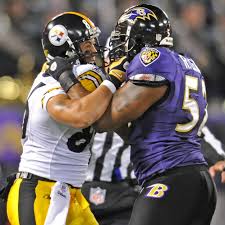
Suggs, Ward, 6x, Ed vs Troy, 3-0 in playoffs, 8-8,Tebow, 0.3, sideline two-step, bounty, Porter, Lewis, Harrison, Scott, antler spray, rape, murder, “hardest I’ve ever been hit”, “respect”. These are just a few numbers, names, words, or phrases that makes the Steelers Ravens the best current rivalry in the NFL both on and off the field.
Rivalries. If you tune into one of the three and four letter sports stations for more than five minutes, you will hear the subject being discussed. Talking heads are constantly arguing over the best college rivalry, best NFL rivalry, and even the broad “best rivalry in sports” (not to mention rivalries in tennis, golf, and even India vs Pakistan field hockey… who knew). The more they argue, the more categories are added to the equation in order to justify their choices. The top two of over a dozen categories are “traditional rivalries” like Chicago Bears vs Green Bay Packers, and Ohio State Buckeyes vs Michigan Wolverines (they may or may not be great currently, but have stood the test of time with 50+ years of history); and “new rivalries” like Seattle Seahawks vs San Francisco 49ers, or “Lebron James’s current team” vs the next best team in NBA’s Eastern Conference. Ravens vs Steelers according to “experts” still fits into the “new” category, but the rivalry has also been at or near the top of said category for over a decade. This recency, intensity, and longevity puts the Ravens Steelers rivalry into a class by itself.
Over the last 16 years, the Steelers and Ravens have split 32 regular season games.
Over the last 14 NFL seasons, the Steelers and Ravens have played in nine AFC Championship games, and represented the AFC in five Super Bowls, winning four.
There are many other reasons why the Ravens/Steelers rivalry is in another class, and it took an off-the-field catalyst, pre-Ravens existence, to help set the rivalry spark into a smoldering fire.
Baltimore and Pittsburgh have had professional football teams at the same time for 35 years before the Browns came to Baltimore and were renamed the Ravens. The teams were never in the same division, and were rarely good at the same time. The Steelers early struggles from 1933-1971 have been well documented, while Baltimore entered the professional ranks as the Colts in 1947, then again in 1953. The Baltimore Colts went without a losing season from 1957-1971, amassing three NFL championships and a Super Bowl victory. Despite the Colts and Steelers early record discrepancy and the fact that they rarely played one another, a flickering of a rivalry was there for the NFL to harness, probably because of proximity and similarities of their blue-collar brethren. When they did play, their attendance figures were the highest of the season- for both cities.
In 1972 the infamous Robert “Bob” Irsay took control of the Baltimore Colts, and coincidentally had three straight losing seasons. Although they enjoyed a few years of success soon after, due almost single handedly to their young QB and RB duo of Bert Jones and Lydell Mitchell, the lack of talent caught up to them, leading to three playoff losses from 1975-1977 by a combined score of 105-70, two of those at the hands of the Steelers. If the previous attendance figures weren’t a sign of a potential rivalry, these playoff results may have stirred up the masses into what modern folk refer to as “trash talk”. Meanwhile, 1972 in Pittsburgh could not have been better. It marked the beginning of the Steel Curtain, their AFC dominance, and four Super Bowl victories in six years. 1972 also began the Steelers own streak without a losing season (13 years). During the Steelers successful run, Baltimore was stuck in AFC’s basement, and its community was dealing with Bob Irsay’s actions (or lack of), which caused a team mutiny against him, alienated fans, resulted in the stadium deteriorating, and eventually led to the team moving to Indianapolis.
Colts fans had essentially three choices when picking a new team: Remain with the Colts (which some did, and the NFL continued to show Colts games as Baltimore home games); adopt the Redskins (which is what the NFL, Paul Tagliabue, and Jack Kent Cooke wanted, and attempted to ram down the fan’s throats), or adopt the Steelers. Many chose the latter because of proximity, to spite Tagliabue and Cooke, and probably to ride the Steelers recent success . This integration of fans into a city is what makes this rivalry different from any other. Sure, many if not most who chose other teams went back to being passionate Baltimore fans, but some still linger who decided to stick with their adopted team.
The Ravens Steelers rivalry was already a perfect storm of proximity and fan interest. Add a rival’s fanbase integrated into the city, followed by years of success by both teams, two to three divisional games per year, dozens of antagonistic players,players conduct off-the-field, and modern social media trolling by both fans and players, you get the 2014 version of this passionate and undisputed best current rivalry in the NFL.
But when you watch the most intense, trash-talking, hardest hitting game in the NFL this Saturday night, the hatred you see on and off the field may have startedlong before the Ravens and Steelers ever played a single game.



























Facebook
Twitter
RSS